 W
WThe Revolutions of 1917–1923 was a revolutionary wave that included political unrest and revolts around the world inspired by the success of the Russian Revolution and the disorder created by the aftermath of World War I. The uprisings were mainly socialist or anti-colonial in nature. Some socialist revolts failed to create lasting socialist states. The revolutions had lasting effects in shaping the future European political landscape, with for example the collapse of the German Empire and the abdication of the German Kaiser.
 W
WThe 1923 Kraków riot was a violent riot that took place during a strike on 6 November 1923 in Kraków, Poland. The incident is also called the 1923 Kraków uprising, particularly by Marxist sources. Demonstrators took control of the Main Market Square area and disarmed some troops. Eventually troops and police were ordered to fire on the workers, though some soldiers refused. Three armored cars were used, one of which, named Dziadek ("Grandpa"), was captured by the workers in the Market Square area. Some 18–30 workers were killed, as well as 14 soldiers. No policemen died, but 31 were injured.
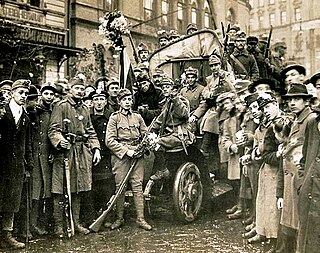 W
WThe Aster Revolution or Chrysanthemum Revolution was a revolution in Hungary led by Count Mihály Károlyi in the aftermath of World War I which resulted in the foundation of the short-lived First Hungarian People's Republic.
 W
WThe Battle of George Square was a violent confrontation in Glasgow, Scotland between Glasgow City Police and striking Glasgow workers, centred around George Square. The 'battle', also known as "Bloody Friday" or "Black Friday", took place on Friday 31 January 1919, 82 days after the end of the First World War. During the riot, the Sheriff of Lanarkshire called for military aid, and British troops, supported by six tanks, were moved to key points in Glasgow. The strike leaders were arrested for inciting the riot. Although it is often stated that there were no fatalities, one police constable died several months later from injuries received during the rioting.
 W
WThe Biennio Rosso was a two-year period, between 1919 and 1920, of intense social conflict in Italy, following the First World War. The revolutionary period was followed by the violent reaction of the Fascist blackshirts militia and eventually by the March on Rome of Benito Mussolini in 1922.
 W
WThe Communist Workers' Party of Germany was an anti-parliamentarian and left communist party that was active in Germany during the time of the Weimar Republic. It was founded in April 1920 in Heidelberg as a split from the Communist Party of Germany (KPD). Originally the party remained a "sympathising member of Communist International." In 1922 the KAPD split into two factions, both of whom kept the name but are referred to as the KAPD Essen Faction and the KAPD Berlin Faction.
 W
WThe First Red Scare was a period during the early 20th-century history of the United States marked by a widespread fear of far-left extremism, including but not limited to Bolshevism and anarchism, due to real and imagined events; real events included the Russian 1917 October Revolution and anarchist bombings. At its height in 1919–1920, concerns over the effects of radical political agitation in American society and the alleged spread of communism and anarchism in the American labor movement fueled a general sense of concern.
 W
WThe Hamburg Uprising was an insurrection during the Weimar Republic in Germany. It was started on 23 October 1923 by one of the most militant sections of the Hamburg district Communist Party (KPD), the KP Wasserkante. Rebels stormed 24 police stations, 17 in Hamburg and seven in Schleswig-Holstein Province in Prussia. From a military point of view, the attempt was futile and over within three days. Without support from the rest of Germany and the Soviet Union, the communist insurgency disintegrated. Some 100 people died during the uprising. The exact details of the rebellion, as well as the assessment of its impact, are controversial to this day.
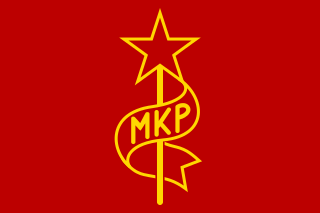 W
WThe Hungarian Communist Party, known earlier as the Party of Communists in Hungary, was a communist party in Hungary that existed during the interwar period and briefly after World War II.
 W
WThe Hungarian–Romanian War was fought between Hungary and Romania from 13 November 1918 to 3 August 1919. The conflict had a complex background, with often contradictory motivations for the parties involved.
 W
WHMS Kilbride was a sloop of the Kil class which were also referred to as gunboats, built for the Royal Navy during the First World War. It was designed for anti-submarine warfare, but was completed too late in the war to be used extensively in that role. The class were designed to be double-ended to confuse submarine observers, and were painted in dazzle camouflage.
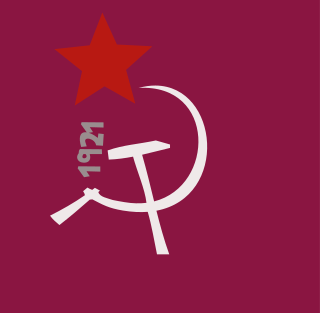 W
WThe Labin Republic was a short-lived self-governing republic that was proclaimed by miners from the Istrian city of Labin on March 2, 1921 during a mining strike. It was created in what has been described as the world's first anti-fascist uprising.
 W
WThe March Action (German "März Aktion" or "Märzkämpfe in Mitteldeutschland" was a 1921 failed Communist uprising, led by the Communist Party of Germany, the Communist Workers' Party of Germany, and other far-left organisations. It took place in the industrial regions located in Halle, Leuna, Merseburg, and Mansfeld. The revolt ended in defeat for the Communists, and a weakening of contemporary Communist influence in Germany.
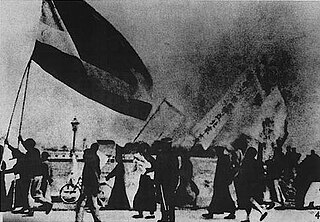 W
WThe May Fourth Movement was a Chinese anti-imperialist, cultural, and political movement which grew out of student protests in Beijing on 4 May 1919.
 W
WThe Mongolian Revolution of 1921 was a military and political event by which Mongolian revolutionaries, with the assistance of the Soviet Red Army, expelled Russian White Guards from the country, and founded the Mongolian People's Republic in 1924. Although nominally independent, the Mongolian People's Republic was a satellite state of the Soviet Union until a third Mongolian revolution in January 1990. The revolution also ended the Chinese Beiyang government's occupation of Mongolia, which had begun in 1919. The official Mongolian name of the revolution is "People's Revolution of 1921" or simply "People's Revolution".
 W
WGermany saw significant political violence from the fall of the German Empire and the rise of the Weimar Republic through the German Revolution of 1918–1919, until the rise of the Nazi Party to power in 1933 when a Nazi totalitarian state was formed and opposition figures were arrested. The violence was characterised by assassinations by and confrontations between right-wing groups such as the Freikorps, and socialist organisations such as the Communist Party of Germany.
 W
WThe Rand Rebellion was an armed uprising of white miners in the Witwatersrand region of South Africa, in March 1922. Jimmy Green, a prominent politician in the Labour Party, was one of the leaders of the strike.
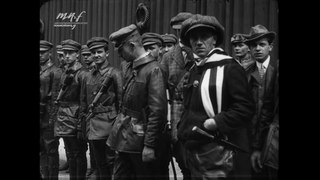 W
WThe Red Terror in Hungary was a period of repressive violence and suppression in 1919 during the four-month period of the Hungarian Soviet Republic, primarily towards anti-communist forces, and others deemed "enemies of the state". According to Robin Okey, The communist party and communist policies had considerable popular support among the proletarian masses of large industrial centers - especially in Budapest - where the working class represented a higher ratio of the inhabitants. In the Hungarian countryside, according to John Lukacs, the authority of the government was often nonexistent, serving as a launch-point for anti-communist insurgency. The new government followed the Soviet method: the party established its revolutionary terror groups to "overcome the obstacles" of the "worker's revolution". It received its name in reference to the Red Terror of Soviet Russia. It was soon followed by the White Terror against communists, industrial workers and Jews.
 W
WThere was a period of revolutions and interventions in Hungary between 1918 and 1920. The First Hungarian Republic was founded by Mihály Károlyi during the Aster Revolution in 1918. In March 1919, the republic was overturned by another revolution, and the Hungarian Soviet Republic was created. The unresolved conflicts led to wars between Hungary and its neighbor states in 1919. The Hungarian Soviet Republic ceased to exist after the Romanian occupation. The Treaty of Trianon in Versailles chilled the conflicts and beneficiaries for this event were Romania, the newly formed states of Czechoslovakia, and the Kingdom of Serbs, Croats and Slovenes.
 W
WThe Ruhr uprising or March uprising (Märzaufstand) was a left-wing workers' revolt in the Ruhr region of Germany in March 1920. The uprising took place initially in support of the call for a general strike issued by the Social Democrat members of the German government, the unions, and other parties in response to the right-wing Kapp Putsch of 13 March 1920.
 W
WThe Seattle General Strike of 1919 was a five-day general work stoppage by more than 65,000 workers in the city of Seattle, Washington from February 6 to 11. Dissatisfied workers in several unions began the strike to gain higher wages, after two years of wage controls during World War I. Most other local unions joined the walk-out, including members of the American Federation of Labor (AFL) and the Industrial Workers of the World (IWW). Government officials, the press, and much of the public viewed the strike as a radical attempt to subvert American institutions.
 W
WThe Sejny Uprising or Seinai Revolt refers to a Polish uprising against the Lithuanian authorities in August 1919 in the ethnically mixed area surrounding the town of Sejny. When German forces, which occupied the territory during World War I, retreated from the area in May 1919, they turned over administration to the Lithuanians. Trying to prevent an armed conflict between Poland and Lithuania, the Entente drew a demarcation line, known as the Foch Line. The line assigned much of the disputed Suwałki (Suvalkai) Region to Poland and required the Lithuanian Army to retreat. While the Lithuanians retreated from some areas, they refused to leave Sejny (Seinai), because of its major Lithuanian population. Polish irregular forces began the uprising on August 23, 1919, and soon received support from the regular Polish Army. After several military skirmishes, Polish forces secured Sejny and the Lithuanians retreated behind the Foch Line.
 W
WThe September Uprising was an armed insurgency staged in September 1923 by the Bulgarian Communist Party (BCP) under Comintern pressure and attempted to overthrow Alexander Tsankov's new government of Bulgaria that had come to power with the coup d'état of 9 June. Besides its communist base, the uprising was also supported by agrarians and anarchists. The uprising's goal was the "establishment of a government of workers and peasants" in Bulgaria.
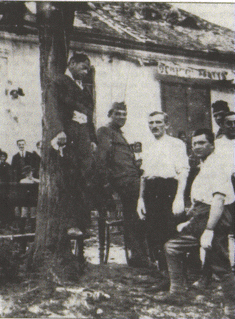 W
WThe White Terror in Hungary was a two-year period (1919–1921) of repressive violence by counter-revolutionary soldiers, carried out to crush any opposition supportive of Hungary's short-lived Soviet republic and its Red Terror. Many of the victims of the White Terror were Jewish. During the White Terror, tens of thousands were imprisoned without trial and as many as 1,000 people were killed.